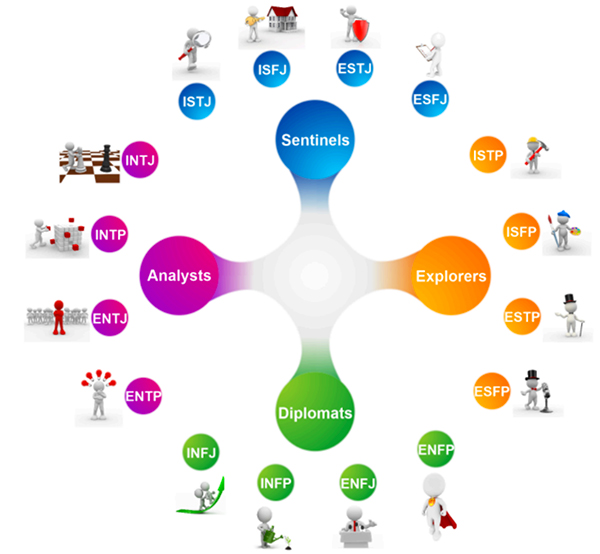
While the Myers-Briggs Type Indicator (MBTI) began as a tool for self-discovery, it has become a widely used tool for building high-performing publishing teams. It provides users with a valuable self-diagnostic tool for seeing ourselves as others see us. It also gives us a shared context for understanding how others are different – not better or worse – just different from us and those around us.
This makes the MBTI valuable in facilitating the creation of an open, nonjudgmental environment that is necessary to the successful formation and maintenance of high-performance teams.
[text_ad]
If you haven’t read our post on why we use the MBTI to improve team performance, read it now. Then take a quick version of the MBTI test.

Above is a graphic that breaks down the 16 different personality types into their most basic forms for publishing teams.
Working Within Personality Types on Publishing Teams
While there aren’t good or bad MBTI types, some tend to correlate more to success in certain positions. When the MBTI types aren’t as natural a fit, it’s particularly important to be aware of that and how individuals and the organization can act to compensate.
Shawn Bakker wrote an excellent guide to managing a multitype team called Working With People With Different MBTI ® Type Preferences, that you might find helpful. Here’s how we’ve translated those guidelines into managing a multiplatform publishing team.
If you’re an Introvert in an Extrovert team:
Your team loves to talk out loud about their ideas, even if you prefer to write them out first. In order to mesh better with an extroverted team, find time in your day to take advantage of quiet moments in the office and on your way to work so that you’re prepared to voice your ideas in meetings when the opportunity arises. A well-thought out plan can also be communicated initially through email, but don’t let the fear of having to publicly present your ideas hold you back from growing within the team.
If you’re an Extrovert in an Introvert team:
Your team is a little less vocal in nature. You might find that they prefer completing tasks and communicating through email while you’re eager to walk into their office or request a formal meeting. When in meetings, take time to encourage your team members to speak their ideas, and give them time to think about your ideas before asking for feedback. You may also benefit from networking outside of the office.
If you have a preference for iNtuition, and your teammates have a preference for Sensing:
Your team likes getting to the point, the most effective way possible. Take time to practice offering information in a step-by-step fashion with examples that illustrate your points. When offered instructions yourself, read each step carefully. While growth requires innovation, respect that there is experience within your organization you can learn from first.
If you have a preference for Sensing, and your teammates have a preference for iNtuition:
While you might get lost in the details, your team analyzes the big picture. Work on your team-building and brainstorming skills by getting involved in more long-term group projects. Instead of honing in on the specifics, practice looking for patterns, meanings, and themes.
If you have a preference for Thinking, and your teammates’ preference is Feeling:
Being blunt may get a point across, but it doesn’t build a motivated team. Practice finding the positive side of every situation, and work on your people skills when it comes to offering constructive criticism. Look for things you can agree on before you begin to disagree.
If you have a preference for Feeling, and your teammates have a preference for Thinking:
In the multiplatform publishing environment, ideas will be accepted and rejected regularly, so practice the fine art of accepting feedback graciously, even when it’s critical. When making your own arguments, try to find logical points of debate, like the results of feedback and other data.
If you have a preference for Perceiving, and your teammates’ preference is Judging:
Your team appreciates sound decisions, strict deadlines, and planning. In order to work best with this type of team, work with them to explain how your decisions are made, and avoid surprising them with new deadlines or challenges too often.
If you have a preference for Judging, and your teammates have a preference for Perceiving:
Your team might not be as disciplined as you, so learn how to create your own deadlines, or try to find projects you can work on that have milestones and deadlines that will help keep you organized. In order to work best with your team, you may also find the need to listen more before coming to any final decisions.
Creating a Team Profile for Publishing Teams
Team building must begin by creating a profile of each team member using the MBTI instrument and then combining the data from those individual profiles to form a team profile. The process creates an opportunity for team members to know themselves better, know their teammates better, and finally to understand how to combine their strengths to create a powerful, effective team.
Often, when you take a few people and put them together and ask them to do something, they will take on their own type with a bias toward the type of the CEO. During our recent Intensive, we combined the team member profiles into one composite case study that ended as an ESTJ, which, as predicted, was also the same profile as the CEO. As you’ll learn next week, we find that ESTJ and ENTJs are the most effective CEOs, and there are many logical reasons why.

Next, see which personality types work best in the executive positions of a multiplatform publishing team. I’ll also explain in which order you should hire so that every new position adds revenue (not just cost) to your bottom line.
If you need help organizing your multiplatform publishing team let’s schedule a call to discuss your five-year goals.
Below, leave a comment and share your experience organizing publishing teams, for better or for worse.
This article was originally published in 2015 and has been updated.
[text_ad]


